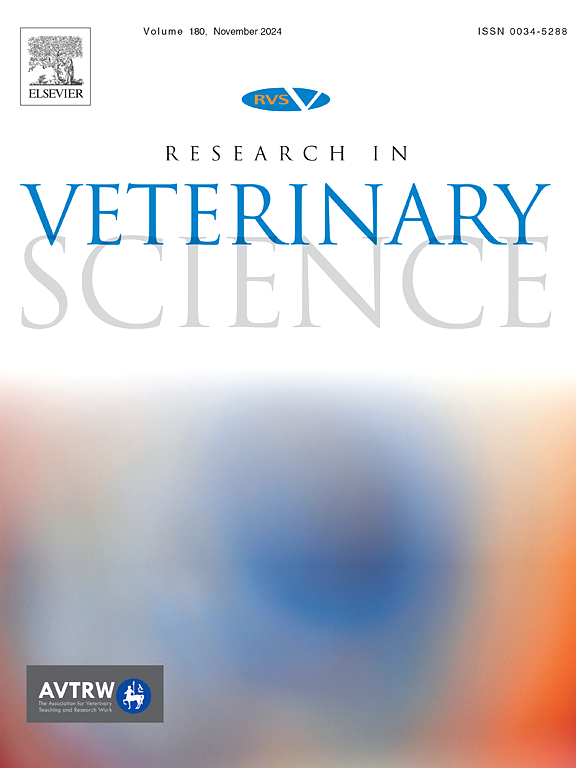心脏生物标志物:用于表征英国牛头梗心脏病表型的激素原b型利钠肽和心脏肌钙蛋白I的n端片段
IF 2.2
3区 农林科学
Q1 VETERINARY SCIENCES
引用次数: 0
摘要
激素原b型利钠肽(NT-proBNP)和心肌肌钙蛋白I (cTnI)的n端片段分别为心脏病犬的临床检查提供心脏负荷和功能以及心肌损伤的信息。英国斗牛梗(BT)有一个复杂的心脏表型倾向。这项前瞻性病例对照研究旨在通过心脏生物标志物评估进一步表征这种表型。包括15名健康BT(第1组)和50名有不同心脏病表现的BT(第2-4组)。主要表现为MVD(45只)和MS(13只)。50只狗中有16只有心脏重构的超声心动图证据:7只左房(LA)或左室(LV)容积增加(3组),9只左房和左室(LV)容积增加(4组)。患有疾病亚型MVD或MS的狗与患有其他疾病的狗之间的心脏生物标志物没有显着差异。当评估与重塑的关系时,第4组(1004 pmol/L, 0.09 ng/mL)的NT-proBNP和cTnI中位数显著高于第1组(257 pmol/L, 0.02 ng/mL)、第2组(300 pmol/L, 0.026 ng/mL)和第3组(250 pmol/L, 0.02 ng/mL)。4组与1、2、3组对两种生物标志物均有显著的区分能力。此外,cTnI显著区分了具有任何程度重塑的狗(3 + 4组)和没有重塑的狗(1 + 2组)。BT的心脏病表型与独特的心脏生物标志物特征无关。相反,生物标志物水平与其他品种的心脏瓣膜病相似。本文章由计算机程序翻译,如有差异,请以英文原文为准。
Cardiac biomarkers N-terminal fragment of the prohormone B-type natriuretic peptide and cardiac troponin I for characterization of the cardiac disease phenotype of the English Bull Terrier
The N-terminal fragment of prohormone B-type natriuretic peptide (NT-proBNP) and cardiac troponin I (cTnI) contribute information regarding cardiac load and function and myocardial injury, respectively, to the clinical work-up of dogs with heart disease. The English bull terrier (BT) has a predisposition to a complex cardiac phenotype. This prospective case-control study aimed to further characterize this phenotype through cardiac biomarker evaluation.
Fifteen healthy BT (group 1) and 50 BT with various heart disease presentations (groups 2–4) were included. The main presentations were MVD (45 dogs) and MS (13 dogs). 16/50 dogs had echocardiographic evidence of cardiac remodeling: 7 with either increased left atrial (LA) or left ventricular (LV) volumes (group 3) and 9 with increased LA and LV volumes (group 4).
Cardiac biomarkers were not significantly different between dogs with disease subtypes MVD or MS versus dogs with other disease presentations. When evaluated in relation to remodeling, median NT-proBNP and cTnI in group 4 (1004 pmol/L, 0.09 ng/mL) were significantly higher than in group 1 (257 pmol/L, 0.02 ng/mL), group 2 (300 pmol/L, 0.026 ng/mL) and group 3 (250 pmol/L, 0.02 ng/mL). There was significant discriminatory ability for both biomarkers between group 4 and groups 1, 2 or 3. Furthermore, cTnI significantly differentiated dogs with any degree of remodeling (groups 3 + 4) from those without (groups 1 + 2).
The cardiac disease phenotype of the BT is not associated with a unique cardiac biomarker profile. Rather, biomarker levels are similar to those reported in other breeds with valvular heart disease.
求助全文
通过发布文献求助,成功后即可免费获取论文全文。
去求助
来源期刊

Research in veterinary science
农林科学-兽医学
CiteScore
4.40
自引率
4.20%
发文量
312
审稿时长
75 days
期刊介绍:
Research in Veterinary Science is an International multi-disciplinary journal publishing original articles, reviews and short communications of a high scientific and ethical standard in all aspects of veterinary and biomedical research.
The primary aim of the journal is to inform veterinary and biomedical scientists of significant advances in veterinary and related research through prompt publication and dissemination. Secondly, the journal aims to provide a general multi-disciplinary forum for discussion and debate of news and issues concerning veterinary science. Thirdly, to promote the dissemination of knowledge to a broader range of professions, globally.
High quality papers on all species of animals are considered, particularly those considered to be of high scientific importance and originality, and with interdisciplinary interest. The journal encourages papers providing results that have clear implications for understanding disease pathogenesis and for the development of control measures or treatments, as well as those dealing with a comparative biomedical approach, which represents a substantial improvement to animal and human health.
Studies without a robust scientific hypothesis or that are preliminary, or of weak originality, as well as negative results, are not appropriate for the journal. Furthermore, observational approaches, case studies or field reports lacking an advancement in general knowledge do not fall within the scope of the journal.
 求助内容:
求助内容: 应助结果提醒方式:
应助结果提醒方式:


